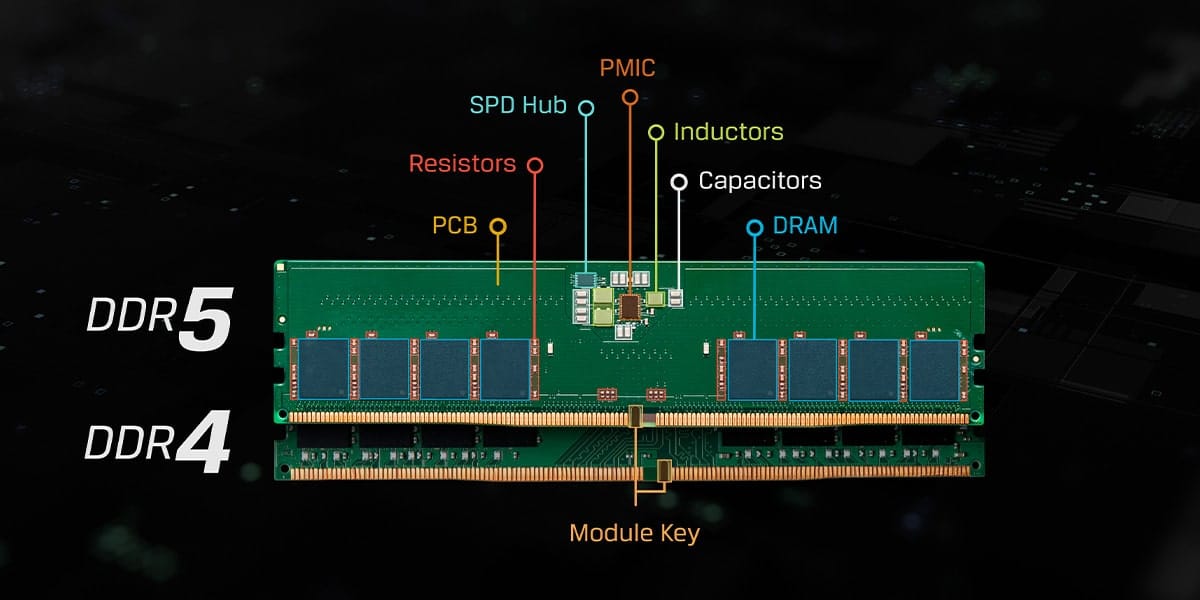Faster, more efficient, and featuring new functions that redefine system performance: this is DDR5 memory, the new standard replacing DDR4 in PCs, workstations, and servers.
Since its debut in 2021, DDR5 (Double Data Rate 5) has been one of the most significant updates in computing system architecture in the last decade. Designed by JEDEC with support from leading manufacturers, DDR5 meets the increasing demand for performance, energy efficiency, and reliability for next-generation platforms.
Next, we break down its main features and how it improves on its predecessor, DDR4, across all key fronts.
Performance: From the Limit of DDR4 to the Launch of DDR5
| Feature | DDR4 | DDR5 |
|---|---|---|
| Initial Speed | 1,600 MT/s | 4,800 MT/s |
| Current Maximum Speed | 3,200 MT/s | 8,800 MT/s (and rising) |
| Bandwidth | Up to 25.6 GB/s | Up to 70.4 GB/s (DDR5-8800) |
| Subchannels | 1x 64 bits | 2x independent 32 bits |
| Internal ECC (ODECC) | No | Yes, on all DDR5 chips |
The jump in bandwidth is significant: DDR5 offers up to 50% more performance even in its base configuration (4,800 MT/s), with a projection to exceed 10,000 MT/s in the coming years. This performance is crucial for demanding tasks such as AI, 3D rendering, big data, or competitive gaming.
Energy Efficiency and Advanced Architecture
DDR5 introduces structural improvements that enhance its efficiency and robustness compared to DDR4:
- Reduced Consumption: DDR5 operates at 1.1 V, compared to DDR4’s 1.2 V, resulting in a 20% energy savings.
- Integrated PMIC: Power management moves to the module, enhancing stability and reducing electrical noise.
- Internal ECC: All DDR5 chips include on-die error correction (ODECC), increasing system reliability.
- Increased Bank Count: DDR5 doubles the number of banks from 16 to 32, improving data access efficiency.
Simplified Technical Comparison
| Technology | DDR4 | DDR5 |
|---|---|---|
| Voltage (V) | 1.2 V | 1.1 V |
| PMIC | No | Yes (5 V or 12 V depending on type) |
| Internal ECC | No | Yes (ODECC) |
| Subchannels | 1x 64 bits | 2x independent 32 bits |
| Burst Length | 8 | 16 |
| Extra Thermal Sensor | No | Yes (in server RDIMM) |
| Scalable Speed | Up to 3,200 MT/s | Up to 8,800 MT/s (2025) |
| New Form Factors | No | New: CAMM2, MCRDIMM, MRDIMM |
What Does This Mean for Users and Professionals?
For Home Users and Gamers:
- Greater smoothness in gaming at high resolutions.
- Improved multitasking performance, especially on platforms with many-core CPUs.
- Compatibility with overclocking profiles like Intel® XMP 3.0 and AMD EXPO™.
For Workstations and Creators:
- Reduction of bottlenecks in graphic and editing workloads.
- Enhanced stability thanks to internal ECC.
- Support for larger capacities: 24 GB, 48 GB, and up to 96 GB per DIMM thanks to 24 Gbit and 32 Gbit chips.
For Enterprise and Server Environments:
- Lower energy consumption per DIMM.
- DDR5 RDIMM modules with thermal sensors for better cooling.
- Advanced ECC and higher memory density per slot.
Compatibility and Transition
Even though DDR5 modules have a similar physical appearance to DDR4, they are not compatible with each other. The position of the central notch is different, and the voltage requirements are distinct. Currently, all Intel 12th, 13th, and 14th generation platforms, as well as AMD AM5 (Ryzen 7000 and 8000), support DDR5 natively.
Conclusion: DDR5 Is Present and Future
DDR5 memory is not just an evolution; it is a reinvention of the concept of RAM in the modern computing ecosystem. It offers more performance, lower consumption, greater reliability, and better scalability. Whether for home, professional, or enterprise use, migrating to DDR5 means entering a new technological phase designed to maximize the potential of future processors and workloads.
Brands like Kingston, Corsair, G.Skill, Crucial, Patriot, and ADATA already offer a wide range of DDR5 modules for desktops, laptops, and servers, catering to all types of budgets and needs.
Image via Kingston.

